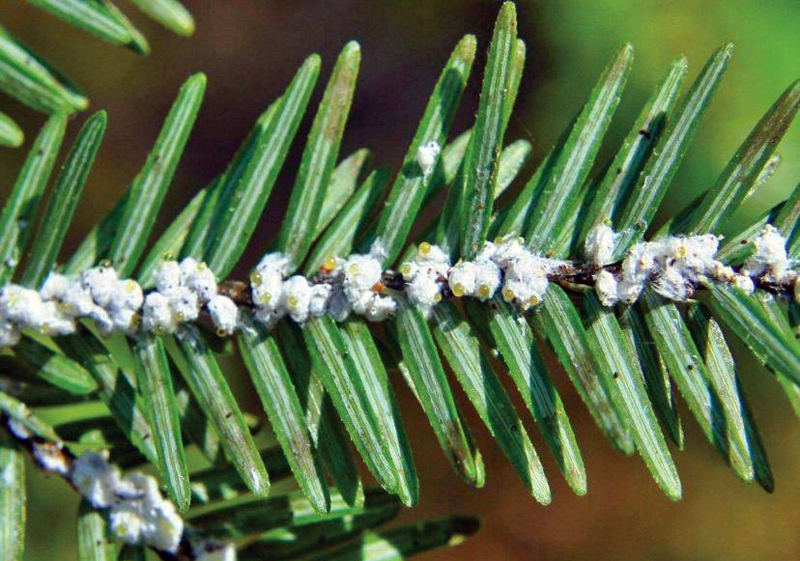
The destructive hemlock woolly adelgid is a white, phid-like pest decimating coastal hemlocks. (Courtesy photo)
The hemlock woolly adelgid, a small, invasive aphid-like species, was introduced to the eastern United States in 1927. Native Northeastern U.S. hemlocks, like the eastern hemlock, show no resistance to the species and have been gravely impacted. As of 2020 the Maine Forest Service has established quarantines in nine counties that stretch from York to Hancock County. All of Lincoln County is under quarantine, which means that hemlocks may not be transported from the area.
The hemlock woolly adelgid slowly travels via wind and on animal and human hosts through the movement of nursery plants and equipment. The range in our area expands about five miles per year. Hemlocks growing in stressful sites, poor soil drainage, compacted soil or that are exposed to drought situations are more likely to die within two to five years. Healthier hemlocks can withstand the infestation longer but remain sickly for decades.
In March and April, adults of the overwintering generation will lay up to 300 eggs within their woolly covering. The newborn hatch from April through May, and then settle on the twigs near the bases of the needles and start feeding on the needles. The hemlock woolly adelgid weaken the tree by depleting its store of carbohydrates. This then reduces the ability to move water, so needles dry out and turn grey or yellow.
So what can property owners do to protect their hemlocks? The first step is to regularly monitor them with visual inspections of the undersides of branches. February is an excellent time to look for the hemlock woolly adelgid because the white wool is clearly visible. Start with the large hemlocks that are wind breakers as they sometimes are the first infected. A 10X loop can be used for magnification. Check the lower limbs first. There are other insects that can be mistaken for hemlock woolly adelgid so, if in doubt, contact the Maine Forest Service or a local tree pest control professional.
The optimum organic treatment that has been implemented on a trial basis has been to release three species of predatory beetles to consume the adelgid. To date, these beetles have not been able to keep up with adelgid reproduction rates and it could take several years to establish themselves before they can overcome the population.
Small, very localized infestations can be treated through pruning and destroying affected branches. Trees can be sprayed with organic dormant oil or insecticidal soap, or a systemic insecticide. When it comes to tree spraying, there are unfortunately a limited number of thoroughly effective organic treatments. Insecticides can be applied to the hemlocks through different application methods. Insecticide can be applied as a soil drench or can be applied through targeted soil injection or an injection to the trunk of the tree. The trunk of the tree can also be sprayed.
Considerations may be necessary, however, as many pesticides should not be used near water or when nearby vegetation is in bloom or on some soil types. Toxicity to pollinators is very low because bees are not attracted to hemlock pollen and few flowering plants can grow under the shade of a hemlock. To protect both yourself and the environment, apply the pesticide only in strict accordance with label directions and precautions.
The hemlock woolly adelgid will not disappear immediately after treatment but will eventually. Examine your trees the following year after applying treatment to ensure that it was effective. Different treatments have different longevity and some may need to be repeated in two- to five-year spans.
(David Brown owns Safeyard Organics, a landscape tree and property pest inspector and applicator. For more information, go to safeyardorganics.com or call 333-0681.)



